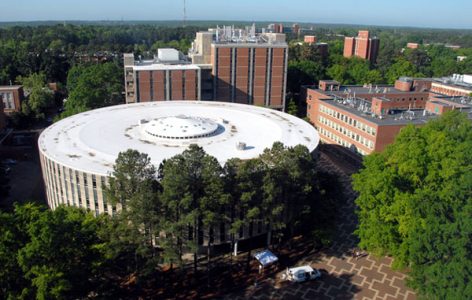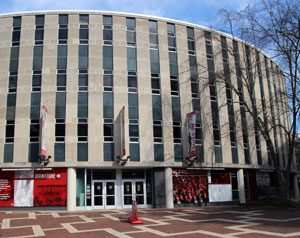
The first round classroom building constructed on a university campus is coming down in 2016, and NC State’s goal is to send as little of the 55-year-old Harrelson Hall to the landfill as possible.
“We’re aiming for 90 percent diversion of nonhazardous materials through recycling and reuse efforts,” said Steve Bostian, a project manager for NC State’s Capital Project Management.
The deconstruction of Harrelson Hall, which opened in November 1961 with about 109,000 square feet of space, comes following a 2003 study that determined the building was too costly to renovate and bring up to current code. Chiefly, it’s the building’s circular structure that creates accessibility problems, as well as limitations in updating fire safety equipment and other mechanical systems. Plus, the building’s low ceilings create visibility issues in classrooms with projectors and other teaching technology.

While the building won’t be removed from campus until summer 2016, salvage work on the interior has already begun. The project’s construction waste management plan specifies that reusable items be saved for another use on campus or donated to Habitat for Humanity. These items include desks, chairs, chalkboards and whiteboards, doors, security cameras and some electric metering and fire protection equipment. All other nonhazardous building material will be taken to a facility that specializes in construction and demolition waste.
“There, the materials are sorted and sent to various markets for reuse and recycling. For example, the concrete blocks making up Harrelson’s structure can be crushed and reused as roadbed,” said Liz Bowen, a university program coordinator specializing in sustainable buildings.
Hazardous materials within the structure – including asbestos, which was widely used around the time of the building’s construction – will be abated and properly disposed of prior to deconstruction.
After deconstruction, the footprint of the building will be landscaped into green space and footpaths, which will improve stormwater management in the area. A Science Commons classroom building, which is already on the university’s list of potential capital projects, could be Harrelson’s replacement. One thing is for sure – it won’t be round.